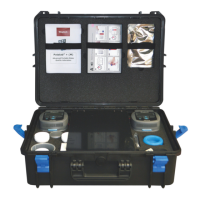4.1 Collecting the Sample for Analysis
Samples can be collected using the sterilised
sampling cup of the Membrane Filtration
Unit (MFU).
It is supplied
with a cord
to allow the
sampling cup
to be lowered
into a water
course, well or
storage tank.
IMPORTANT: Always rinse the sterile sampling
cup with some of your sample water before taking
the final sample. This eliminates any residual
methanol left over from the sterilisation process.
Care must be taken not to introduce floating matter
or material from the edge of the water course into
the water sample. It may be preferable to attach the
sampling cable to the sterilised sampling cup and
take the sample from a bridge or other overhanging
location. Alternatively, the cup may be cast into the
water from the edge and pulled slowly and carefully
back towards the operator.
Alternatively, any suitable sterile container or
sample bottle can be used in place of the
sampling cup.
When sampling from a river or stream take the
sample as near as possible to the main flow and
not too close to the edge where the water may be
still and unrepresentative of the sample as a whole.
When sampling from a tap or outlet that provides
water for a consumer remove any tap attachment.
Clean the tap/outlet with a dry cloth before allowing
to run for 1 minute prior to sample collection.
Once collected, the sample must be processed
immediately or as quickly as possible. The use
of a portable field test kit makes this possible.
However, if the delay between sample collection
and analysis is between 2 and 6 hours, chill the
sample rapidly to about 4°C with ice blocks in
an insulated container/cool bag. Resuscitate
the sample prior to full incubation using the
automated routine contained within the
Wagtech incubator software.
Even if the sample is kept cold, the maximum
sample storage time is 6 hours. Analysis of
samples not stored under these conditions or
processed after a period of 6 hours are unlikely
to reflect the bacteriological conditions at the
time of sampling.
If chlorinated water samples are being
collected, sodium thiosulphate (not supplied
with kit) should be added to the sample bottles
to neutralise chlorine.
15
4
Taking a Sample
4.0 Taking A Sample
The optimum volume of sample is that which will allow the most accurate enumeration of bacteria.
The technique of membrane filtration is unsuitable for natural waters containing very high levels of
suspended material, sludges and sediments, all of which could block the filter before an adequate
volume of water has been filtered.
For potable or treated water samples the number of faecal coliform bacteria should ideally be zero in
100ml, indicating a microbiologically safe (or more accurately LOW RISK) water supply. The preferred
sample volume is 100ml.
For raw source waters and partially treated waters, including those derived from ground water, it is
sometimes useful to reduce the sample volume to obtain faecal coliform counts in the optimum range.
This may be a reduction of the sample size to 50ml, or even 10ml in more contaminated water sources.
To aid this, the filter funnel of the membrane filtration unit has two internal graduations at 50ml and 100m
l.
100ml
50ml

